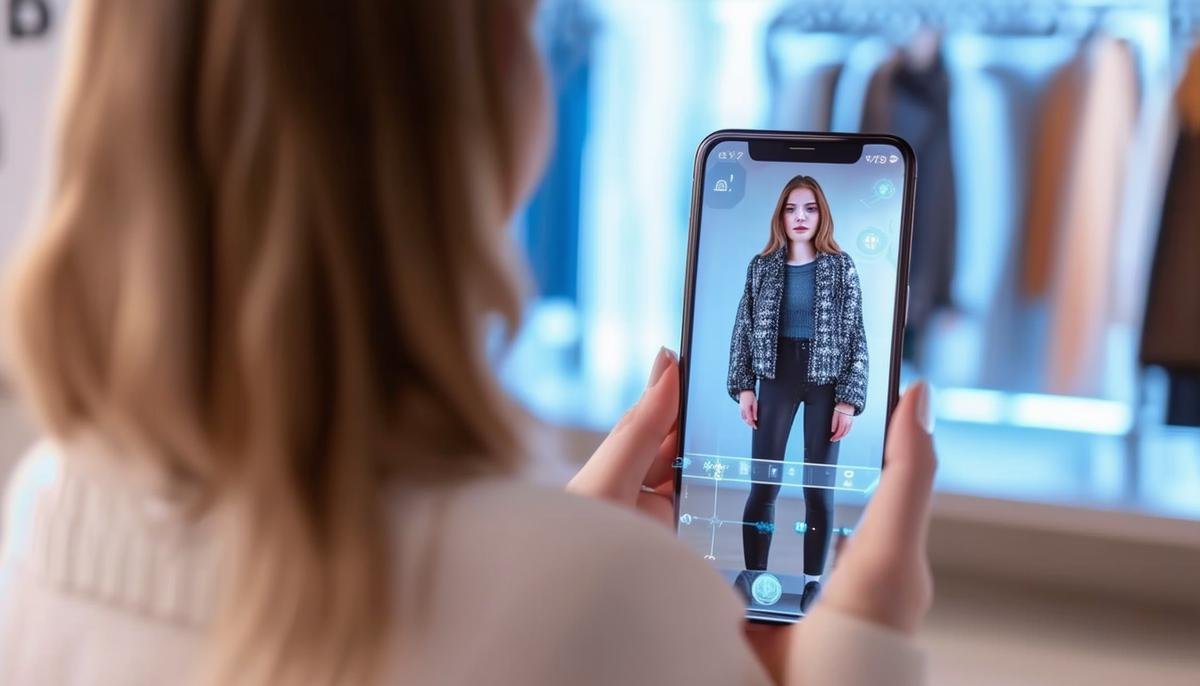Stitch Fix’s AI-Powered Personalization
Stitch Fix distinguishes itself with its AI personalization. Stitch Fix gathers 90 specific data points via a detailed survey, including style preferences, favorite colors, dress size, height, and location. By analyzing this data, AI recommends clothing aligned with individual tastes, making shopping feel tailored.
Natural language processing contextualizes written feedback from customers, interpreting why an item was loved or returned. If a dress was too tight in the arms but perfect elsewhere, AI picks up on that detail.
The collected data provides insights for the merchandising team, informing smarter purchasing decisions. For instance, trends like “cabincore” or “clementine” color predictions for 2023 came through these aggregated insights. It’s about meeting demand with the right supply.
Customers engage with a carousel of items, indicating preferences. The AI absorbs these choices to better align future recommendations. There’s nothing like feeling understood when every item resonates with your style.
AI aids in assigning warehouses for fulfillment and seasonal forecasts too. It’s an integrated system optimizing every step, ensuring the right piece reaches the right customer at the right time.
Pre-trained language models craft product descriptions based on existing style guides. Experts review these for accuracy, creating a seamless and personalized experience.
Stitch Fix’s “probability of sale” model predicts the likelihood of purchase for each SKU, fed with new data daily, including responses from the Style Shuffle, written feedback, and customer interactions like Pinterest activity.
This blend of AI and human expertise shapes a personal experience in retail. The AI suggests items for the stylist, but ultimately, a human decides, adding judgment and artistry. It streamlines the process, making everything more efficient yet keeping it human-centric.
Stitch Fix’s approach creates value for everyone. It provides insights for its own inventory and shares valuable data with partner brands. Having detailed info helps brands adjust their designs for a better fit, boosting sales.
Stitch Fix is revolutionizing retail tech, making every recommendation count. Whether predicting trends, improving fit, or crafting personalized shopping experiences, Stitch Fix’s AI applications bring out the best in both tech and human capabilities.

AI-Driven Design and Creativity
AI-driven design and creativity might sound futuristic, but it’s part of today’s fashion scene. Stitch Fix’s Outfit Creation Model (OCM) generates about 13 million outfit combinations daily using algorithms trained on millions of outfits curated by human stylists. OCM considers real-time inventory and past customer purchases, crafting styling suggestions that resonate with individual tastes. The marriage of human creativity and machine efficiency gives customers fresh and exciting style inspiration.
Mango collaborates with AI to translate initial sketches and color concepts into finished designs, resulting in over 20 unique garments. Calvin Wong’s AiDA system generates blueprints from initial design sketches and color ideas, offering designers suggestions without overshadowing their creative essence. AiDA contributed to over 80 outfits with innovative design elements during “Fashion X AI.”
Nike used AI to design the eco-friendly ISPA Universal shoe by fusing three previous models. Generative AI extends beyond apparel to accessories, with brands like Acne Studio using text-to-image models to turn design briefs into stunning pieces.
AI assists designers in crafting street-inspired ensembles, enabling rapid concept generation and unique silhouettes. AI’s ability to quickly iterate and test multiple design versions ensures that what hits the production line is both stylish and aligned with current trends.
From dynamic outfit combinations at Stitch Fix to avant-garde designs on the runway, AI is crafting the future of fashion, making it smarter, more inclusive, and undeniably more exciting.

Optimizing Supply Chain and Inventory Management
Stitch Fix optimizes supply chain and inventory management through AI. AI-powered algorithms scour through historical data and current trends to anticipate future styles that will be in high demand. These predictive models analyze countless variables to forecast what inventory is needed and when.
AI translates these insights into actionable steps. Stitch Fix uses a sophisticated recommendation engine to guide merchants on inventory decisions. This innovative system considers billions of possible scenarios, making it possible to forecast up to 12 months ahead. It identifies hidden gems—items that might not have been best-sellers but fulfill a specific need for certain customers.
This system smartly allocates products to the right warehouses, ensuring quick and precise order fulfillment. AI assigns products based on factors like geographical demand and shipping efficiency.
Companies like H&M and Zara integrate AI into their supply chain management using RFID technology and smart clothing tags, improving inventory visibility and enabling better forecasting decisions. AI promotes sustainability by minimizing waste, with Refiberd’s AI Waste Sorting System utilizing hyperspectral imaging to sort textile waste efficiently for recycling.
AI-driven trend forecasting takes things further. Heuritech uses AI to analyze millions of social media images daily to provide the latest trend analysis, helping brands swiftly adapt their collections to align with current customer preferences.
Amazon examines customer reviews to provide personalized size recommendations, avoiding unnecessary returns and ensuring clothing fits perfectly. Rent the Runway leverages AI to minimize return-related issues by gathering detailed feedback on fit and style from nearly every renter.
AI’s application in supply chain and inventory management exemplifies its power to revolutionize the intricate dance of supply and demand. With such systems in place, the future of fashion retail looks more efficient, sustainable, and attuned to modern consumers’ needs.

Enhancing Customer Experience with Virtual Try-Ons
Imagine browsing for the perfect pair of jeans, but you’re unsure about the fit. Enter AI-driven virtual try-ons, revolutionizing the online shopping experience by addressing one of the biggest pain points—sizing and fit.
- Nike Fit turns your smartphone into a personal fitting room, scanning your feet and recommending the perfect shoe size by leveraging years of purchasing data and user feedback.
- Stitch Fix’s algorithms delve into customer feedback, gathering detailed fit information to recommend a specific fit, say a 6.4 or an 8.3, tailoring the experience.
- Amazon analyzes customer reviews to provide personalized summaries related to garment fit, suggesting whether to size up or down based on aggregated reviews from similar body types.
- Walmart’s “Be Your Own Model” feature allows customers to upload their photos and see how clothes will look on their specific body type, making shopping more enjoyable and less risky.
- Levi’s collaboration with Lalaland.ai generates virtual models for try-ons, catering to diverse body types and sizes, ensuring inclusivity and addressing frustrations many shoppers face with misrepresented body types.
- Google’s AI-powered virtual try-on for Google Shopping increases accuracy and representation in virtual fittings, currently available for over 40 women of different shapes and colors.
These advancements drive a significant decrease in returns, benefiting retailers and customers alike. A well-fitted garment pleases the customer and fosters brand loyalty, while reducing carbon emissions from returned items and promoting a circular economy.
“Rent the Runway utilizes AI to correlate fit data from every rental, continuously refining their size recommendations and leading to high-fit, exclusive collections, resulting in a 45% reduction in fit-related issues.”
AI-driven virtual try-ons are transforming the fashion industry by providing tailored, precise, and inclusive shopping experiences. From personal mobile fitting rooms to sophisticated size algorithms, this technology sets a new standard for creating a confident, enjoyable, and personalized shopping journey.

Trend Forecasting with AI
Stitch Fix blends big data with the nuanced art of fashion prediction to forecast trends. Millions of social media images, customer reviews, and purchasing patterns are analyzed by AI to identify emerging trends before they hit the mainstream. This granular approach allows Stitch Fix to curate highly relevant and fashionable collections by detecting surges in demand for specific aesthetics or colors.
At its core is AI’s ability to observe patterns and forecast future demands. Companies like Heuritech and Trendalytics leverage AI to mine retail insights from social media, Google trends, and customer interactions. This rapid insight allows designers to be nimble, adjusting collections to meet evolving customer tastes and staying ahead of competitors.
For Stitch Fix, AI-driven trend forecasting informs purchasing decisions, ensuring their inventory aligns with customer wants. It also aids in creating exclusive designs by understanding unmet needs and desires, enabling them to co-create styles that are fashionable and perfectly suited to their customers.
This technology fosters a more sustainable approach to fashion by predicting trends accurately, reducing overproduction and waste. Companies like Mango’s ‘Inspire‘ platform collaborate with AI to transform initial design concepts into finished products that don’t just follow trends but set them. The resulting designs are innovative, yet perfectly aligned with what the market will be looking for.
AI’s role in trend forecasting creates a feedback loop that continually refines the fashion process. Whether interpreting social media chatter, customer feedback, or historical purchasing data, these insights empower brands to stay perpetually ahead, ensuring every new collection meets and exceeds customer expectations. The future of fashion isn’t just data-driven; it’s dynamically designed to meet the ever-changing tastes of a global audience.

Ultimately, AI’s integration into fashion is about creating a smarter, more responsive, and sustainable industry. By leveraging data and human expertise, companies like Stitch Fix are setting new standards in customer experience and operational efficiency, shaping an intelligent and exciting future for fashion.




